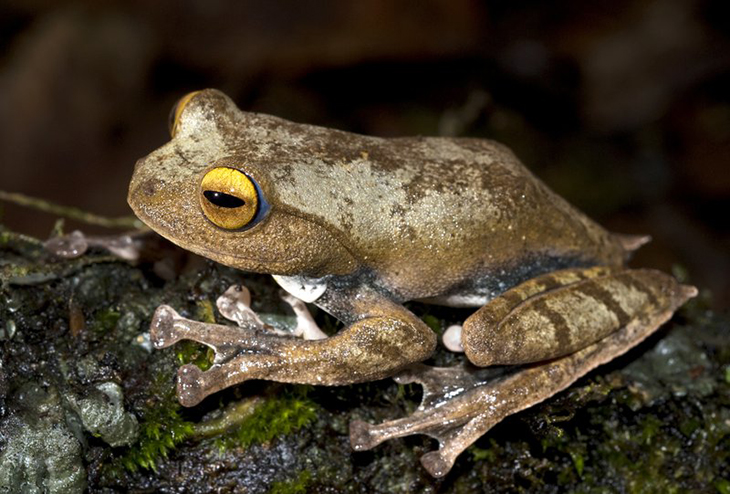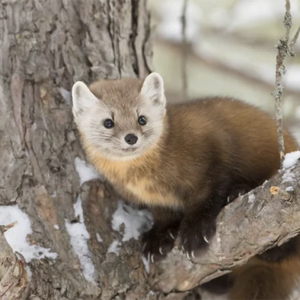
In a recent study featured in the journal PLOS ONE, scientists have unveiled the discovery of the tiniest fanged frog species ever documented. Typically, the dental features of frogs are unremarkable, resembling small, pointed projections along the upper jaw. However, a peculiar adaptation distinguishes a particular group of frogs inhabiting streams in Southeast Asia: two prominent bony “fangs” protruding from their lower jaw.
This unique characteristic is observed in more than 70 species of these frogs, colloquially known as Dracula frogs. The purpose of these fangs extends beyond mere aesthetics; they play a crucial role in territorial disputes and competition for mates among the amphibians. Astonishingly, the fangs also serve as formidable tools for these frogs in predation, enabling them to engage with challenging prey such as large centipedes and crabs.
The research, conducted in collaboration with the Bogor Zoology Museum, was undertaken by a team from the McGuire Lab at Berkeley. Their exploration led them to Sulawesi, a rugged and mountainous island that forms part of Indonesia, where they discovered this newly identified species of fanged frog.
“It’s a giant island with a vast network of mountains, volcanoes, lowland rainforest, and cloud forests up in the mountains. The presence of all these different habitats mean that the magnitude of biodiversity across many plants and animals we find there is unreal—rivaling places like the Amazon,” said Jeff Frederick, the study’s lead author. He is also a postdoctoral researcher at the Field Museum in Chicago.
“This new species is tiny compared to other fanged frogs on the island where it was found, about the size of a quarter,” Frederick said.
“Many frogs in this genus are giant, weighing up to two pounds. At the large end, this new species weighs about the same as a dime.”
While traversing the dense jungle, members of the collaborative US-Indonesia research team dedicated to the study of amphibians and reptiles stumbled upon an unexpected discovery adorning the leaves of tree saplings and the surfaces of moss-covered boulders: clusters of frog eggs.
Frogs, being amphibians, follow a unique reproductive process wherein they lay eggs encased in jelly rather than a rigid, protective shell. Typically, to prevent desiccation, amphibians opt for aquatic environments to deposit their eggs. To the astonishment of the research team, they consistently observed these terrestrial egg masses positioned on leaves and mossy boulders, elevated several feet above the ground. Shortly thereafter, the team started to encounter the diminutive, brown-hued frogs themselves, adding a layer of intrigue to their exploration.
“Normally when we’re looking for frogs, we’re scanning the margins of stream banks or wading through streams to spot them directly in the water,” Frederick says. “After repeatedly monitoring the nests though, the team started to find attending frogs sitting on leaves hugging their little nests.”
Maintaining intimate proximity to their eggs enables frog parents to apply protective compounds, preventing moisture loss and safeguarding against bacterial and fungal infections.
Upon closer scrutiny of the amphibian parents, it was discovered that they belonged to the diminutive fanged frog family, possessing barely noticeable fangs. Interestingly, the caretakers of the egg clutches were exclusively male frogs.
“Male egg-guarding behavior isn’t totally unknown across all frogs, but it’s rather uncommon,” Frederick explained.
Frederick and his team propose a hypothesis suggesting a potential connection between the distinctive reproductive behaviors observed in the frogs and their smaller-than-average fangs. This speculation is based on the comparison with some of the frogs’ relatives that possess larger fangs, serving as a means to fend off competitors vying for desirable locations along the river where they typically lay their eggs in the water.
The reasoning behind the hypothesis is that the newly discovered frog species, scientifically named Limnonectes phyllofolia (with “phyllofolia” signifying “leaf-nester”), has evolved a unique strategy for egg-laying away from the water. In the process of adapting to this new reproductive approach, these frogs might have undergone a reduction in the size of their fangs, as they no longer face the same competition for aquatic egg-laying sites that necessitate the use of large and imposing fangs for territorial defense.
“It’s fascinating that on every subsequent expedition to Sulawesi, we’re still discovering new and diverse reproductive modes,” Frederick also added. “Our findings also underscore the importance of conserving these very special tropical habitats. Most of the animals that live in places like Sulawesi are quite unique, and habitat destruction is an ever-looming conservation issue for preserving the hyper-diversity of species we find there. “Learning about animals like these frogs that are found nowhere else on Earth helps make the case for protecting these valuable ecosystems.”
What are your thoughts? Please comment below and share this news!
True Activist / Report a typo


